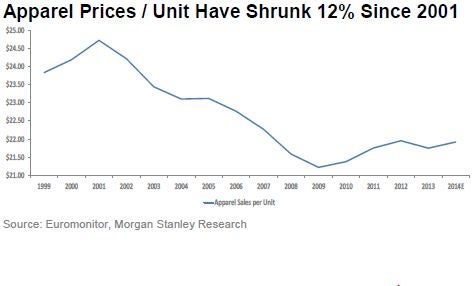Morgan Stanley analysts believe that the price deflation that has plagued the world of U.S. apparel retail![]() is here to stay. In a recent report, analysts forecast a meager 1 to 2 percent apparel sales growth over the next five years.
is here to stay. In a recent report, analysts forecast a meager 1 to 2 percent apparel sales growth over the next five years.

More Consumer Choices
One of the major problems facing the apparel world is that consumers are increasingly spending disposable income![]() on non-apparel products. In 1972, apparel made up 7 percent of personal consumption expenditures in the United States. As of 2013, that number has shrunk to 3 percent, while expenditures such as healthcare, consumer electronics, housing and recreation have all gained share.
on non-apparel products. In 1972, apparel made up 7 percent of personal consumption expenditures in the United States. As of 2013, that number has shrunk to 3 percent, while expenditures such as healthcare, consumer electronics, housing and recreation have all gained share.

Trade Policy Changes
Since the World Trade Organization eliminated textile and apparel quotas in 2005, U.S. apparel retailers have been importing massive amounts of products from low-cost sources such as China and Indonesia. Access to cheaper labor provided opportunity for low-cost American retailers to gain market share.
Fallout From The Great Recession
The economic hardship that came about as a result of the financial crisis made bargain shopping a necessity for many Americans. Morgan Stanley analyst![]() Kimberly Greenberger believes this thriftiness is here to stay. “The emergence of the ‘Recessionista’ made bargain shopping a badge of pride, suggesting a combination of fashionable and savvy shopper.”
Kimberly Greenberger believes this thriftiness is here to stay. “The emergence of the ‘Recessionista’ made bargain shopping a badge of pride, suggesting a combination of fashionable and savvy shopper.”
According to a Consumer Reports study, 59 percent of shoppers wait for a sale to buy apparel, and 47 percent of shoppers share news of a great deal with family and friends.
Apparel prices per unit are down 12 percent since 2001. Analysts believe that companies such as…
Read the rest of this article (and all my other articles) for free on Benzinga by clicking here
Want to learn more about the stock market? Or maybe you just want to be able to look sophisticated in front of your coworkers when they ask you what you are reading on your Kindle, and you’d prefer to tell them “Oh, I’m just reading a book about stock market analysis,” rather than the usual “Oh, I’m just looking at pics of my ex-girlfriend on Facebook.” For these reasons and more, check out my book, Beating Wall Street with Common Sense. I don’t have a degree in finance; I have a degree in neuroscience. You don’t have to predict what stocks will do if you can predict what traders will do and be one step ahead of them. I made a 400% return in the stock market over five years using only basic principles of psychology and common sense. Beating Wall Street with Common Sense is now available on Amazon, and tradingcommonsense.com is always available on your local internet!

